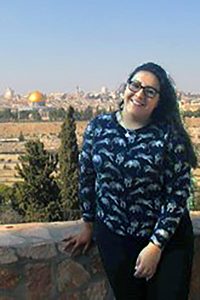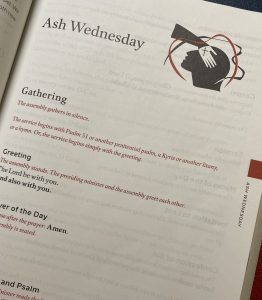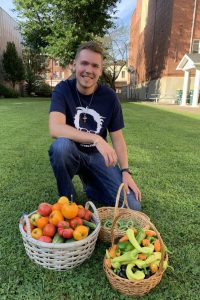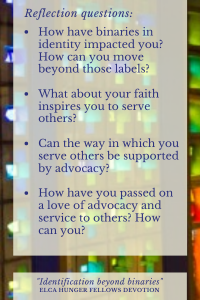Alex Zuber–Harrisonburg, VA
Warm-up Question
How do you respond to authority figures? What does authority mean to you?
Chaos and Authority
On January 20th, 2021, Joseph R. Biden Jr. became the 46th President of the United States and Kamala D. Harris became the first ever woman, black woman, and woman of South Asian descent to be Vice President of the United States. Inauguration Day is central to the peaceful transition of power in the US and showcases the authority to lead the nation. In the midst of this historic day, a powerful voice rose above the rest, as Amanda Gorman became the youngest poet laureate to share her work at a presidential inauguration.
In her poem Ms. Gorman reflected powerfully on the stark juxtaposition of this inauguration day and the January 6th insurrection at the Capitol just two weeks prior. She said, “We will not march back to what was / but move to what shall be /A country that is bruised but whole, / benevolent but bold, / fierce and free / We will not be turned around / or interrupted by intimidation / because we know our inaction and inertia / will be the inheritance of the next generation / Our blunders become their burdens / But one thing is certain: / If we merge mercy with might, / and might with right, / then love becomes our legacy / and change our children’s birthright”
Ms. Gorman reminded us that we have witnessed the chaos of January 6th transformed into the authority of January 20th. It was a powerful transformation, and if we hope to avoid again descending into chaos, authority must be rooted in mercy, goodness, and love. We are moving past the pain of January 6th, but there is still work to do if we truly wish love to be our legacy. This hopeful future hangs in the balance between chaos and authority.
Discussion Questions
- Who are authority figures in your life whom you trust? Why do you trust them?
- Have you seen examples when chaos overcame authority? Why did authority fail?
- How do you think people of faith are meant to respond to chaos in our world?
Fourth Sunday after Epiphany
(Text links are to Oremus Bible Browser. Oremus Bible Browser is not affiliated with or supported by the Evangelical Lutheran Church in America. You can find the calendar of readings for Year B at Lectionary Readings.)
For lectionary humor and insight, check the weekly comic Agnus Day.
Gospel Reflection
In today’s Gospel reading, Jesus enters the temple to teach. He teaches with authority in a way that amazes the people. But what is the source of Christ’s authority? What about his teaching is so incredible to his hearers?
Before we get an answer, a man suddenly appears who has been afflicted with an unclean spirit; in other places in scripture it is called a demon. In many other places in the gospels we see that unclean spirits and demons are chaotic forces, driving a deep separation between people and their communities, seeking to dominate and destroy. They are powerful forces, but seem to tremble in the presence of Christ. This demon attempts to establish its chaotic power over Jesus by calling him by name—an ancient way of gaining power over another—but calmly and firmly Jesus casts the demon out of the man.
It is a dramatic scene, and the people once again rejoice at this “new teaching—with authority!” But the heart of this story is in the foundation of Christ’s authority. His authority is not found in being the biggest, baddest, most powerful force of all. His authority is found in humility and mercy. Christ sides with meek and humble humans, overwhelmed and cut-off from their community. Jesus’ power lies in humility and his work is in restoration. His merciful reign is not about asserting dominance, but about creating hope and restoration. He is the redeemer of the people, subservient even to death on a cross, and it is this humility which topples even the greatest evil forces.
There are plenty of demons in our world. Seemingly insurmountable forces of demonic division like racism, white-supremacy, anti-Semitism, homophobia, and transphobia, seek to gain power over us each day and divide us from one another. But through our baptisms we are one body with Christ. God makes us the priesthood of all believers. Christ’s authority is rooted in hope, mercy, truth, and equity; in response to the grace we have received through Christ, God sends us out as disciples to work for these things. Through our baptisms, we renounce the demons of our time and build up the Kingdom of God. Christ shows us that we won’t defeat these forces through coercive power, but through his authority, rooted in his humility and love. Through God’s grace, we’ve received the promise that this struggle is already won.
Discussion Questions
- Have you experienced “unclean spirits” or demons, i.e., forces which seek to divide, isolate, and diminish through chaos?
- What are ways we can take up Christ’s authority to resist the demons of our day?
- What kind of world would it be if all persons with authority took seriously the call to love, mercy, humility, and equity? Is this world possible?
Activity Suggestions
- Read through the news this week. Where do you see demons? Where do you see the powerful dividing rather than working for equity? Pray over these divisions and talk with a friend about the ways that you might work for peace.
- Visit the ELCA Advocacy, ELCA World Hunger, and Global Church blogs on the ELCA website to look for ways we are working together against injustice today.
- Read over the Baptismal Covenant (pg. 237 in ELW) and discuss with a friend what it means to live into these promises.
Closing Prayer
God of reconciliation, where unclean spirits still seek division, you knit us together into one body of believers through grace and mercy. Send us out with the authority of your Son to work for justice, equity, and reconciliation in his name. Amen.















 Repentance is at the core of Christian living (the first of Luther’s 95 Theses). During the season of Lent, we all become a “penitent” with ashes on the forehead, looking toward to the cross as a sign of God’s reconciliation with all creation (with the absolution on Maundy Thursday). Ashes appear throughout the Hebrew Bible as a sign of mourning and repentance, but Isaiah reminds us that such practices point to the larger call for justice (Isa. 58:5-6). These ashes are at the very beginning (“dust” in Genesis 3:19) and connect each of us to all of creation and to our own mortality.
Repentance is at the core of Christian living (the first of Luther’s 95 Theses). During the season of Lent, we all become a “penitent” with ashes on the forehead, looking toward to the cross as a sign of God’s reconciliation with all creation (with the absolution on Maundy Thursday). Ashes appear throughout the Hebrew Bible as a sign of mourning and repentance, but Isaiah reminds us that such practices point to the larger call for justice (Isa. 58:5-6). These ashes are at the very beginning (“dust” in Genesis 3:19) and connect each of us to all of creation and to our own mortality. The power of receiving the cross on our foreheads on Ash Wednesday is in the layering: there is a sign of sin and death traced and layered on top of the tracing in water and oil of the promise of life, rebirth, and liberation from sin and death. On Ash Wednesday, we feel the full weight of the ashy tracing. It does not negate or obliterate the liberating sign it is layered with, but it is a suitably tangible reminder of the reality of grief, loss, and death.
The power of receiving the cross on our foreheads on Ash Wednesday is in the layering: there is a sign of sin and death traced and layered on top of the tracing in water and oil of the promise of life, rebirth, and liberation from sin and death. On Ash Wednesday, we feel the full weight of the ashy tracing. It does not negate or obliterate the liberating sign it is layered with, but it is a suitably tangible reminder of the reality of grief, loss, and death. Most of my personal study and continuing education for the last several months has been focused on trauma-informed care, recognizing that living through the varied events of the last year affects not only our spirit but also our mind and body, and requires adaptations honoring this challenging new space. A best practice for trauma-informed care is to remember that significant stress and trauma are not just intellectual exercises. Our bodies respond to and reflect the events of the day. It may be using prayer beads or a finger labyrinth to make home worship feel more real or wrapping myself in a favorite sweater or soft blanket when I miss the comforting hugs of family and friends. Being mindful of how my body responds to grief and loss and finding ways to care for and comfort it has been both personally and professionally beneficial.
Most of my personal study and continuing education for the last several months has been focused on trauma-informed care, recognizing that living through the varied events of the last year affects not only our spirit but also our mind and body, and requires adaptations honoring this challenging new space. A best practice for trauma-informed care is to remember that significant stress and trauma are not just intellectual exercises. Our bodies respond to and reflect the events of the day. It may be using prayer beads or a finger labyrinth to make home worship feel more real or wrapping myself in a favorite sweater or soft blanket when I miss the comforting hugs of family and friends. Being mindful of how my body responds to grief and loss and finding ways to care for and comfort it has been both personally and professionally beneficial. Ash Wednesday marks the beginning of a journey when we remember Jesus’ ministry, his ability to heal and care for humanity, and at the same time, his passion, death, and overall, his glorious resurrection. In a “typical” year it might seem too soon to even talk about Easter on Ash Wednesday. However, I don’t know if that’s the case for 2021.
Ash Wednesday marks the beginning of a journey when we remember Jesus’ ministry, his ability to heal and care for humanity, and at the same time, his passion, death, and overall, his glorious resurrection. In a “typical” year it might seem too soon to even talk about Easter on Ash Wednesday. However, I don’t know if that’s the case for 2021.



